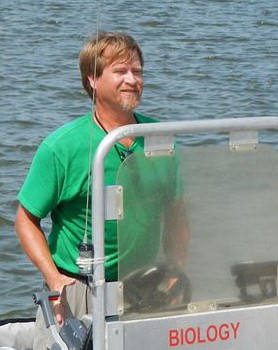LU helps to bring National Science Foundation Research vessel to the Gulf of Mexico
Lamar University is helping bring one of three state-of-the-art National Science Foundation funded oceanographic research vessels to the Gulf of Mexico. This announcement brings the first new regional class research ship in the U.S. Academic Research Fleet to the Gulf of Mexico in nearly four decades.
As one of 15 associate members of the Gulf – Caribbean Oceanographic Consortium, led by the University of Southern Mississippi and the Louisiana Universities Marine Consortium, Lamar University played a role in developing the future scientific agenda for Gulf of Mexico and Caribbean oceanographic research. The Consortium’s efforts ultimately secured the approximately $100 million funding for the National Science Foundation- University-National Oceanographic Laboratory System Regional Class Research Vessel to be built and stationed in Louisiana and Mississippi.
Associate Professor of Aquatic Microbial Ecology, Matthew Hoch  serves as LU’s representative on the Consortium that also includes representatives from Texas A&M University (College Station, Galveston and Corpus Christi), University of Texas Marine Science Institute, Louisiana State University, Tulane University, Dauphin Island Sea Lab, University of Miami, Harbor Branch Oceanographic Institution of Florida Atlantic University, University of Puerto Rico, University of the Virgin Islands, Florida State University, University of South Florida, University of Georgia and the Centro de Investigación Científica y de Educación Superior de Ensenada.
serves as LU’s representative on the Consortium that also includes representatives from Texas A&M University (College Station, Galveston and Corpus Christi), University of Texas Marine Science Institute, Louisiana State University, Tulane University, Dauphin Island Sea Lab, University of Miami, Harbor Branch Oceanographic Institution of Florida Atlantic University, University of Puerto Rico, University of the Virgin Islands, Florida State University, University of South Florida, University of Georgia and the Centro de Investigación Científica y de Educación Superior de Ensenada.
Hoch was invited to join the Consortium in February 2018 because of his extensive work and network of colleagues in biological oceanography. The Consortium’s first attempt to win the grant for a vessel was awarded to the University of Rhode Island and a new East Coast Oceanographic Consortium. With encouragement from NSF to resubmit, USM and LUMCON pulled together the representative oceanographers from the initial consortium institutions for a two-day science agenda workshop in January 2019 in Gulfport, MS. Hoch attended and became part of the team to win the most recent grant.
“We methodically analyzed the knowns and unknowns of the Gulf of Mexico and Caribbean Sea and their seafloor basins,” said Hoch. “A preliminary five-year research agenda was developed, which continued to be worked on through March of this year. USM and LUMSON reached out and accumulated experts in areas where we knew the plan had gaps. The institutions of these additional experts were invited into the consortium, totaling to fifteen associate members at the time of submission in April.”
The new ship, which is expected to be delivered in 2023, will transform regional, national and international research important to the U.S. and the world. With science labs, deck space for scientific deployments and state-of-the-art technologies, the 199-foot ship will enable valuable research on environmental change, the global hydrologic cycle, biodiversity in the ocean and marine mineral resources. The consortium will also create opportunities for students and the public to connect with marine scientists and their work, and it will work collaboratively to build and grow an inclusive, diverse and science-informed community.
“The lack of knowledge of most of the world’s oceans is tremendous, and the Gulf and Caribbean are no exception. despite decades of oceanographic research in the Gulf of Mexico, much of the work has been done close to shore in smaller research vessels,” said Hoch. “The new RCRV will have a range of 5400 NM (6200 mi) so we can study large scale questions not touched on previously.”
The ship will be operational for multidisciplinary collaborations among institutions. The vessel has 12 science berths, where students and faculty can participate in projects while at sea. The vessel will also be used for public and educational outreach events. In addition to bringing the vessel to the Port of Beaumont for public and outreach events, Hoch says he’s looking forward to the new discoveries now possible with such a research ship. Get more information about the NSF research vessel at the Oregon State University website
“One potential project would address impacts of increasing excessive sediment and nutrients from the Amazon River, due to Amazon deforestation, on ocean biology. Surface currents carry these pollutants past the Mesoamerican Barrier Reef, into the Gulf of Mexico and via the Loop Current may pass the reefs of the Florida Keys. For example, Amazon River nutrients have been implicated in the excessive sargassum weed on beaches of Belize, Mexico and Texas.” said Hoch. “Equally exciting is the potential for discovery of new benthic (bottom) life in the multiple basins and deep-sea trenches, and let’s not forget the opportunity to study geological processes and past conditions on Earth in this tectonically active region of the world’s oceans.”
SOURCE: Some information for this news release was sourced from “USM and LUMCON Selected to Lead Consortium to Operate New NSF Regional Class Research Vessel,” at www.usm.edu/news/2019/release.


